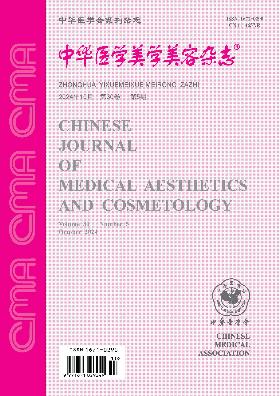动眼神经麻痹引起的假性graefe现象治疗上睑下垂3例
引用次数: 0
摘要
目的探讨颅脑损伤或手术后并发假性Graefe现象的动眼神经麻痹所致单侧上睑下垂的治疗方法。方法收集3例上睑下垂患者,采用改良提上肌切除术矫正上睑下垂。术后观察指标包括上睑缘高度、双眼皮弧度、眼球运动及相应上睑高度的变化、闭眼功能及暴露性角膜炎的发生率。结果1例中度上睑下垂的动眼神经麻痹患者术后上睑高度达到理想,2例重度上睑下垂患者术后矫正不足。三例患者双眼皮弧度均较术前平滑,眼球运动及相应的上眼睑高度均无明显变化。两例重度上睑下垂均能很好地闭上眼睛,而中度上睑下垂患者则不能完全闭上眼睛。结论改良提上睑肌切除术是治疗动眼神经麻痹伴假性Graefe现象的中度上睑下垂的有效方法,但对严重上睑下垂疗效不佳。关键词:眼球运动神经;麻痹;眼睑下垂;假性Graefe现象,上睑下垂;改良提肌切除术本文章由计算机程序翻译,如有差异,请以英文原文为准。
Treatment of blepharoptosis with pseudo-Graefe phenomenon caused by oculomotor nerve paralysis: report of three cases
Objective
To explore the treatment of unilateral blepharoptosis caused by oculomotor nerve paralysis with pseudo-Graefe phenomenon after craniocerebral trauma or operation.
Methods
Three patients suffered from blepharoptosis caused by oculomotor nerve paralysis with pseudo-Graefe phenomenon were collected in this study and the modified levator resection technique was applied to correct ptosis. The observation index after operation included the height of upper palpebral margin, the radian of double eyelid, the change of eye movement and the corresponding upper eyelid height, the eye closure function and the incidence of exposure keratitis.
Results
One case of oculomotor nerve palsy with moderate ptosis achieved an ideal height of upper eyelid after surgery, two cases of oculomotor nerve palsy with severe ptosis were undercorrection. All the three patients had smooth double eyelid radian, no obvious change of eye movement and corresponding upper eyelid height compared with preoperative. The two severe ptoses could close eyes well, but the moderate ptosis patient couldnot close eyes completely.
Conclusions
The technique of modified levator resection is an effective method to treat the moderate ptosis caused by oculomotor nerve paralysis with pseudo-Graefe phenomenon, but the results are unfavorable in the treatment of severe ptosis.
Key words:
Oculomotor nerve; Paralysis; Blepharoptosis; Pseudo-Graefe phenomenon, ptosis; Modified levator resection technique
求助全文
通过发布文献求助,成功后即可免费获取论文全文。
去求助
来源期刊
自引率
0.00%
发文量
4641
期刊介绍:
"Chinese Journal of Medical Aesthetics and Cosmetology" is a high-end academic journal focusing on the basic theoretical research and clinical application of medical aesthetics and cosmetology. In March 2002, it was included in the statistical source journals of Chinese scientific and technological papers of the Ministry of Science and Technology, and has been included in the full-text retrieval system of "China Journal Network", "Chinese Academic Journals (CD-ROM Edition)" and "China Academic Journals Comprehensive Evaluation Database". Publishes research and applications in cosmetic surgery, cosmetic dermatology, cosmetic dentistry, cosmetic internal medicine, physical cosmetology, drug cosmetology, traditional Chinese medicine cosmetology and beauty care. Columns include: clinical treatises, experimental research, medical aesthetics, experience summaries, case reports, technological innovations, reviews, lectures, etc.

 求助内容:
求助内容: 应助结果提醒方式:
应助结果提醒方式:


